This road is broken – and nobody can fix it
The spiders aren't the only thing stopping Ebbsfleet's development
HEY, LISTEN! Check out the latest episode of The Abundance Agenda, where Martin and I discuss why (to my horror) we love Luton Airport, and dig into a mad proposal to change how the Mayor of London works. Plus we speak to the co-founders of a new think tank, the Centre for British Progress about why economic growth is essential to achieving progressive outcomes.
The Abundance Agenda is available on Apple Podcasts, Spotify, Substack and wherever you get your podcasts!
The A226 might not seem like an important road, but for residents and businesses in one corner of North Kent, it is a surprisingly critical link.
Built on top of a spine of chalk, created when land on both sides was quarried out a century ago, the road connects the villages of Swanscombe and Northfleet, crossing over the High Speed 1 railway line.
Perhaps more importantly though, the road accidentally sits at the heart of the government’s growth mission, as it is around these villages that ‘Ebbsfleet Garden City’ is emerging.
Centred around the new International train station1 on the High Speed 1 line, almost every pocket of land adjacent to these two villages, as well as the vast former quarry nearby, will one day be home to tens of thousands of people, living in 15,000 new homes.
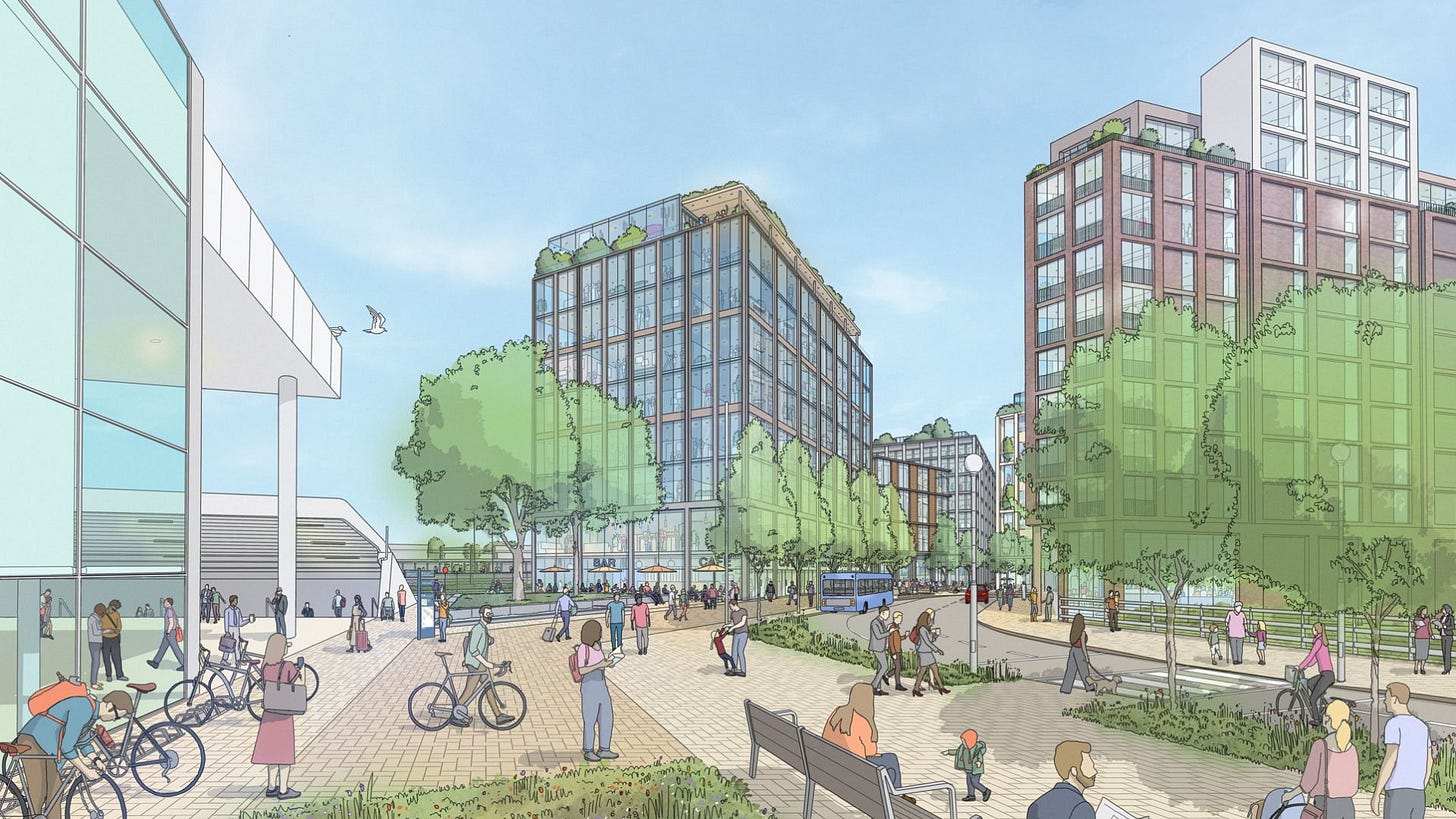
And as it is only 18 minutes from St Pancras station, and 11 minutes from Stratford, Ebbsfleet is a hugely strategic location. Though we need 370,000 new homes every year on a national scale, given the scale of the development it has the potential to deliver a sizeable chunk of this target – and just outside of London too, in the most expensive corner of the country. So though the project began almost twenty years ago, if the current government really cares about building the homes and infrastructure we need to grow the economy, then developments like Ebbsfleet are a critical part of the answer.
Today, around 5000 homes have already been constructed, and the sounds of diggers, drills and clanking metal are a constant in the area. But, in the years since construction began, it has not been plain sailing.

One significant challenge has already been the focus of national attention. Speaking last month, the Prime Minister referred to the problem of “jumping spiders” holding back development – a reference to an order by Natural England to create a Site of Special Scientific Interest covering much of the western half of the “Ebbsfleet Central” development, directly around the train station, as well as the Swanscombe peninsula – the site of a former cement works, which had been intended as the location of a new theme park, until the developers gave up trying.2
However, I’m not writing about the spiders today, as this isn’t the only problem blighting the emergence of Ebbsfleet as a major population centre.
There’s also a significant problem with the A226, otherwise known as Galley Hill Road, which joins together settlements on both sides of the railway line, and is one of the links that will knit this new community together.
Two years ago today, a minor disaster declared the road off-limits – and as things stand there is no sign that it is ever going to be fixed. No construction work has begun. No plan has been finalised. And nobody has taken responsibility for the mess.
And once you dig into what happened, it reveals a story of deep dysfunction in Britain’s institutions, reflective of the broader national malaise that created the zero-growth economy and anti-development state we have today.
If you like nerdy politics, policy and infrastructure chat, then make sure you sign up to my newsletter (for free!) to get more of This Sort Of Thing direct to your inbox.
The landslide

The landslide occurred on the 10th April 2023. In one brief moment, the cliffside of the A226 Galley Hill Road gave way, sending huge chunks of earth crashing to the ground – taking the road with it.
The precise cause has not yet been agreed, but the incident is thought to have happened following reports of a burst water main. Given that chalk is highly permeable, it is conceivable that the broken pipe injected water into the cliff, which structurally weakened it. However, it’s also conceivable that the reverse is true: That failure of the cliff led to the bursting of the pipe. We don’t yet know.
However it occurred though, the consequences were serious. The earth slipped down the north side of the cliff, and ran into warehouses in a small industrial estate below. Luckily, no one was injured as it was a bank holiday, and no one was working on site. But the collapse did knock out water and broadband to homes in the immediate surrounding area. And, of course, the link road on top was indefinitely closed, as both the Kent County Council and Thames Water conducted remediation works, to stop the cliff collapsing any further.
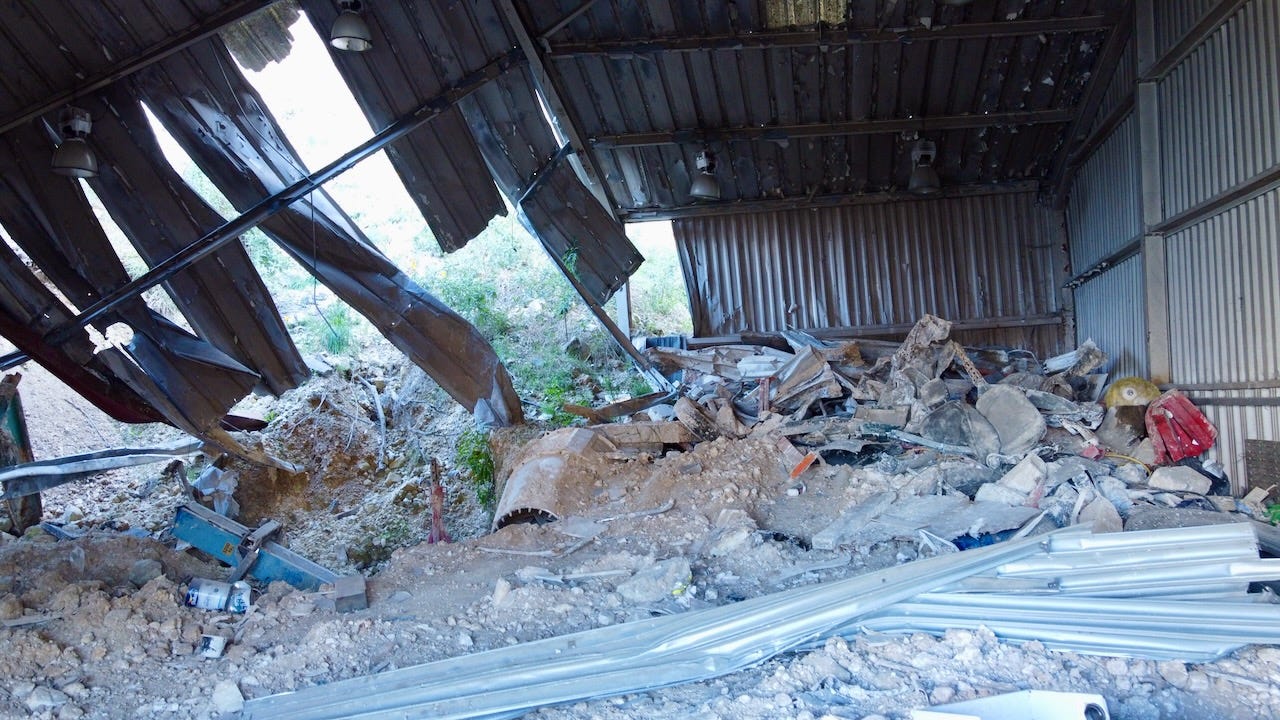
At this point, you might assume that the next step was to repair the road and get it open again. But what actually happened was, seemingly, nothing.
In fact, in December 2023 – eight months after the initial collapse – the Kent County Councillor in charge of highways admitted that they were still “awaiting surveys” of the road and the cliff. And amazingly it wasn’t until the 15th April last year, over a year later, that surveyors were first able to begin work, owing to legal difficulties of accessing the private land around the road. Even then, access difficulties persisted until at least last July for the same reasons.
And similarly, as far as I can tell, it was only earlier this year that possible options for fixing the road had been worked up by the council.
So here we are today, two years on – and not a shovel has been lifted in order to fix the road.
A real world problem
Before I explain some of the reasons why what sounds like a simple thing – fixing a road – is so intractable, it’s worth pausing to consider how miserable the last two years has been for local residents. A really good way to illustrate this is to look at what severing this link has done to the local bus service.
Before the landslide, Galley Hill Road had been on the route of a major bus service. Running roughly every eleven or twelve minutes, the Fastrack B route had connected Swanscombe with Northfleet. But more broadly, it joined together a swathe of North Kent, linking the town of Gravesend with Dartford, as well as the massive Bluewater shopping centre.
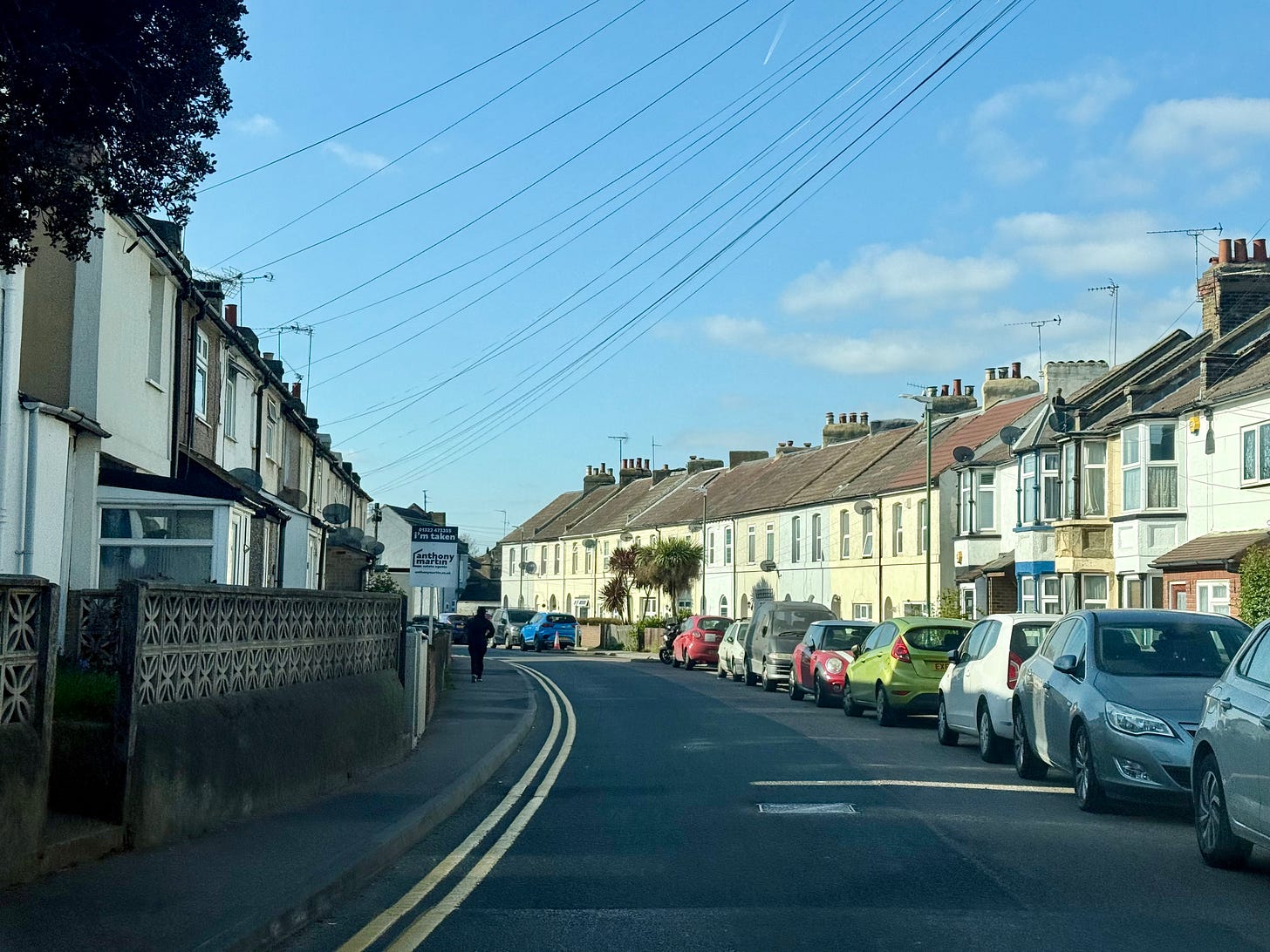
With the road out of commission however, the bus had to be diverted. And though services still run today, the route is obviously less direct – and more fatally, the one local connection that remains between either sides of Galley Hill Road has become significantly busier.
This traffic is obviously not good in its own right, but what makes it worse is now the route – the only route available – is forced to snake through the narrow residential streets of Swanscombe. This was a village built before widespread car usage, and is a place clearly not equipped for the level of vehicle traffic it now receives. In numerous places on the bus route, traffic is reduced to single file, one direction at a time.
Now, as an out-of-touch urbanist at heart, I’m not usually particularly sympathetic to complaints about traffic – but the problem here is that in addition to inconveniencing motorists, it inherently degrades the reliability and regularity of the bus service too.
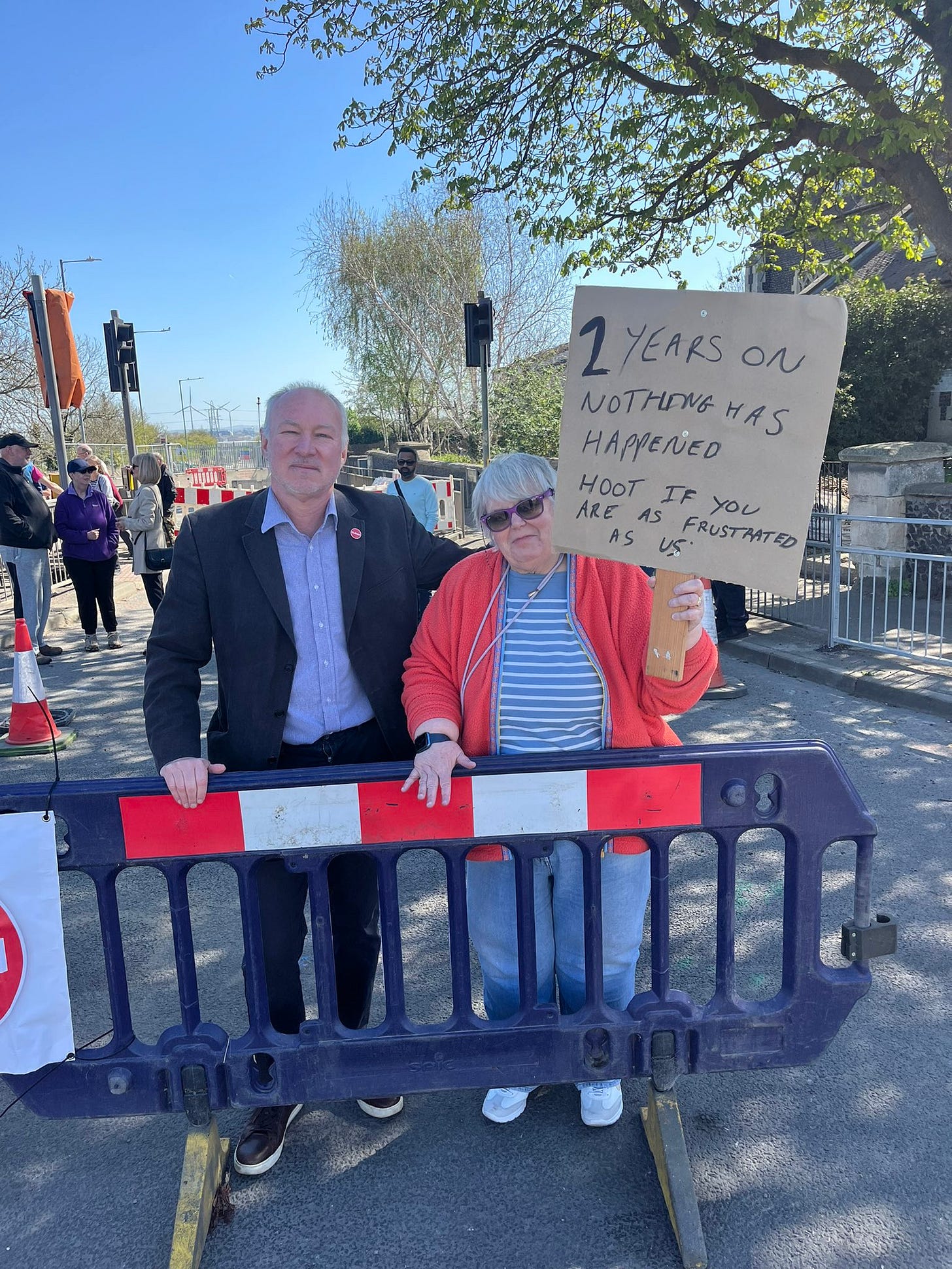
However, buses are just a microcosm, as the impact has been felt more widely.
Sadly, I haven’t been able to work out if the closure has had any impact on housing delivery in the local area. I reached out to the Ebbsfleet Development Corporation to find out – but they declined to comment this side of the local elections.3
Whether or not it has directly affected development of the area though, it has definitely already hit the people who are already living there. For example, local businesses are reportedly losing customers. HGVs, ignoring diversion signs, are thundering through residential areas. And local residents, in what is a low-income area, are having to contend with being effectively cut off from places they could have accessed before. These are all relatively small complaints in the grand scheme of things, but in aggregate, the landslide has made their lives worse.
So the obvious question is: Why the hell is it taking so long to fix?
No villains here?
From a narrative perspective, it would be much easier at this point if I could point to a specific villain. A particular political leader, institution, or actor whose fault it is that nothing has happened.
But really, there isn’t one. There is no scandal here. Instead, for the past two years, life in this pocket of North Kent has deteriorated thanks to a cascading series of problems.
First and foremost, it’s important to note that Galley Hill is a genuinely difficult problem to solve. This isn’t a situation where a new layer of tarmac will do the job. You can see that in the images above. What the landslide revealed was an inherent weakness in the chalk spine the road sat on – so there is no sticking-plaster solution, and a more serious structural redesign is required.
That’s why in recent months, Kent County Council has landed on two possible fixes. One option is to replace the cliff with a bridge, similar to one a little further down the road that crosses the HS1 train tracks.
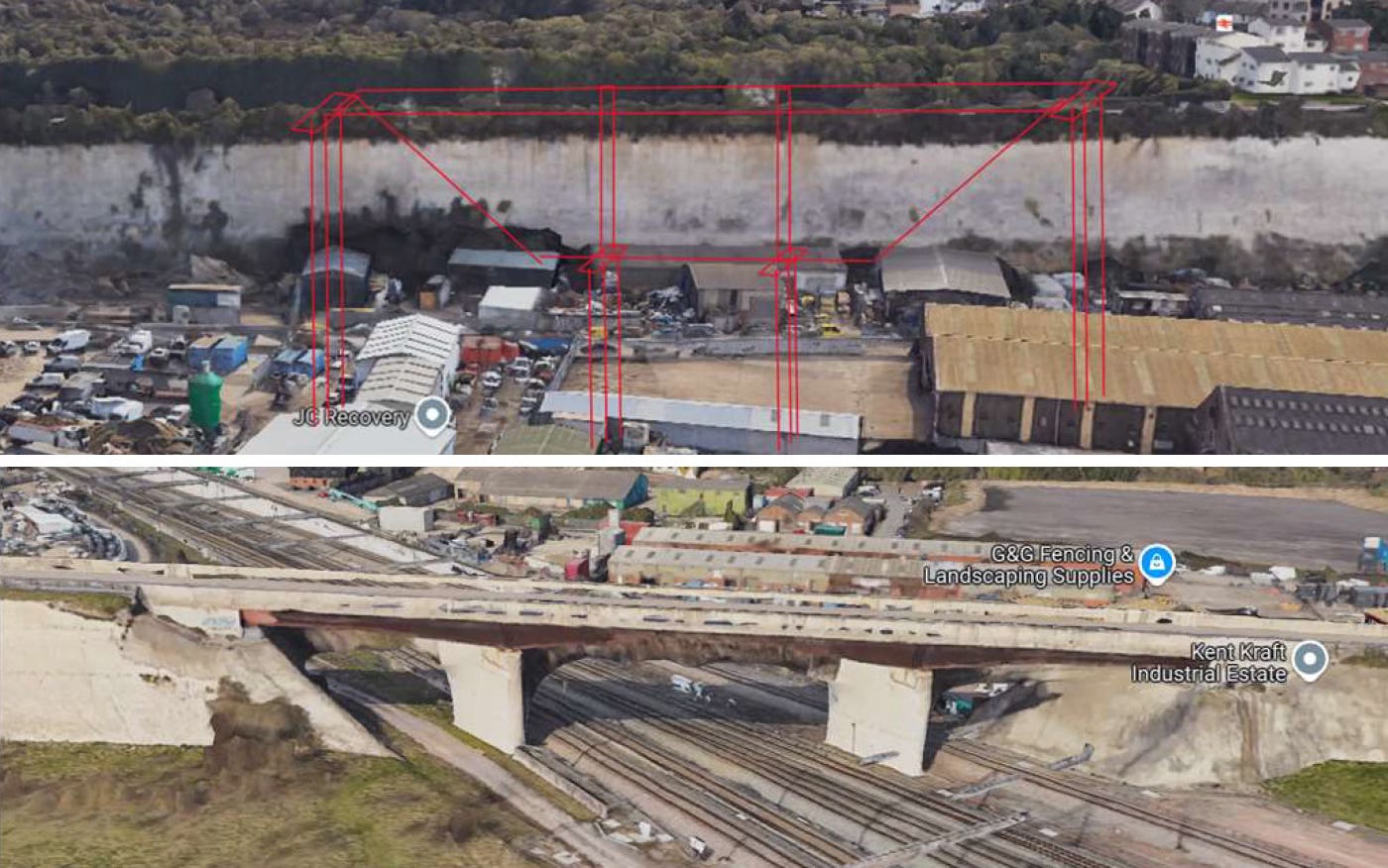
Or the other option is to build the earth embankment back up – presumably with some serious reinforcement.

However, the problems are not just physical engineering problems. There are political factors exacerbating it too.
For example, I understand that essentially no one really wants to take responsibility for the situation. When the collapse happened, one of the first things Thames Water and Kent County Council did was lawyer up, knowing that if they receive the blame, they could be on the hook for a very expensive repair.
And to put this in context, I’ve heard informed speculation that if Kent has to pay for it, then the fix could conceivably take an enormous chunk of the annual roads budget for the entire county – which in 2024/25 was £42m.
This legal dispute then, alongside access issues with nearby private landowners,4 has made surveying the site, let alone attempting to fix it, incredibly difficult.
Arguably though, the question of who pays is largely academic, because neither Thames Water nor Kent has any money. The former appears to be on the brink of nationalisation – and the latter is British local government in the year of our lord 2025.
So one way or the other, it seems likely that the British state will be on the hook for paying for Galley Hill. That is, if it can be persuaded to.
Because here’s the real political problem Galley Hill has faced. For big national disasters, like major floods, the government will usually open the national chequebook once pictures appear on the TV. And for smaller issues, various government departments have pre-allocated pots of cash that can be dipped in to.
For example, the Environment Agency has cash available for flood defence, and something known as the Bellwin Scheme (named for the Tory minister who founded it), exists to pay for emergency first-response needs, like sandbags and recovery centres.
But what about money for middle-sized issues like, say, a landslip that has screwed up a crucial, but not nationally important road that carries an expensive repair bill? As things stand, there is no formal structure – though the Department for Transport can grant cash on an ad-hoc basis.
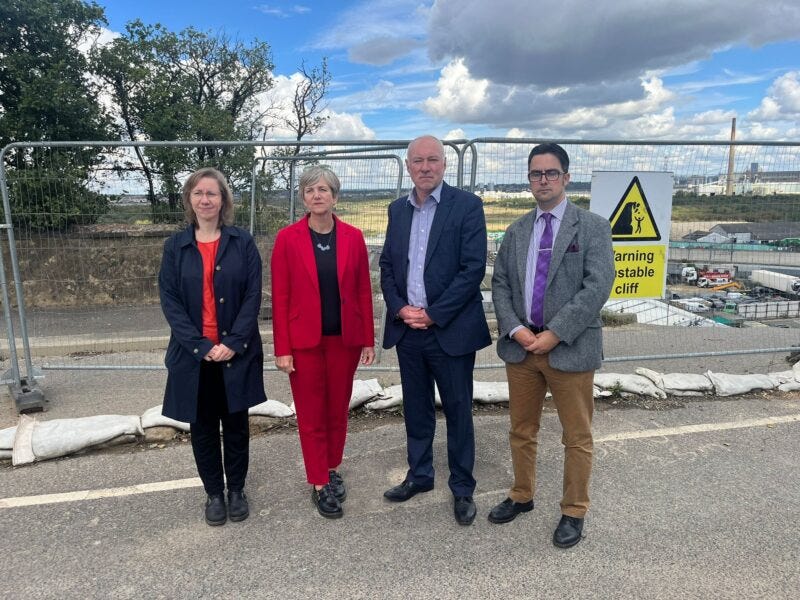
As a result, the only way Galley Hill is now going to be fixed is if the government can be persuaded to pony up. And so far, despite a visit from the roads minister Lillian Greenwood and persistent lobbying by local Labour MP Jim Dickson and his Conservative predecessor, no money has yet materialised.
So despite the obvious inconvenience for Ebbsfleet and its environs, the situation appears to be stuck.
And this is really bad, because Kent County Council estimates that once funding is in place, the design, tendering and procurement process will take an additional year – and then the actual construction of whatever replacement is chosen could take between another 18 months and two years.
This means that even if Keir Starmer wakes up tomorrow and decides he’s more interested in Kent road closures than tariffs and the end of the western alliance, the closure will persist for at least another three years. So the very best case scenario – which is impossible – is that an important link road at the centre of a major new housing project, that is critical to the government’s housing and growth plans, will be out of action for at least five years.
We should be better than this
I know what you’re thinking. Why have I spent 2000 words telling you, in slightly excruciating detail, about a road that you never knew existed, and will likely never need to travel on?
The answer is that it represents something bigger.
On one level, Galley Hill Road is a highly visible consequence of how the capacity of the British state has been degraded. I’m sure it could be wrapped into a story about how austerity wrecked local government finances, which hit the capacity of the local councils to deal with situations like this.
Or perhaps it is more reflective of a culture that does not care about building with resilience? That would explain why Thames Water reportedly had to dig up the adjoining road 47 times in the four years before the collapse, due to previous leaks.
But mostly, I think it is a damning reflection of the inertia in Britain and its institutions.
Why did it take a year to negotiate access for geotechnical surveys? Why are so many different agencies and organisations involved in managing the road, and why do none of them want to own the problem? And most importantly, why is the only solution to what is essentially a local problem to hope that the local MP catches the ear of the right person in Westminster?
No one would design a system to work this way. But that’s what we’ve let evolve, and it matters, as I think it is a part of what my friend and podcast co-host Martin Robbins calls the ‘National User Experience’, which he describes as follows:
“[A] category of things that have been largely abandoned by government yet have a major impact on people’s daily lives and their perception of how the country is being run. Car parks, potholes, neglected public spaces, boarded-up shopping centres, persistent antisocial behaviour, the punctuality of trains - things people encounter day after day after day that make life a little bit harder, a little bit more miserable.”
Viewed through this lens, it is also easy to see the political problem here. Though this case is just a road, and all it means is that journeys are slightly longer, or slightly more congested, I think it matters on a deeper level too. Because if we want people to have faith that the state can actually do stuff, and that democracy actually works – then we need a state that visibly improves people’s lives and doesn’t just leave them feeling abandoned.
And given that nothing tangible has happened at Galley Hill Road for two years now, perhaps we shouldn’t be surprised that when there was a by-election in Swanscombe last November that the seat fell to Reform?
The real scandal
Perhaps Galley Hill Road is just a uniquely difficult situation, owing to the complexity of the problem. But it is far from the only infrastructure where there is not-quite-an-emergency that has left entire areas paralysed for years. An obvious parallel is with Hammersmith Bridge in London, which closed in 2019 because of structural issues, and has been stuck in limbo ever since.
And there must be policy solutions to the issues identified here.
For example, on a macro-level, this strikes me as a situation where regional-level government with properly devolved powers could be effective, because this is the sort of problem that is too big for local government – yet should be far too small for central government to care about.
There must also be other changes that could be made to make government more responsive. For example, could we change procurement rules so. that it doesn’t take a year to appoint a contractor to fix critical roads?
Or could we have a more robust system where declaring an emergency could automatically unlock funding and extra powers for local authorities? I’m not an expert, but I understand in other countries, it’s legally possible to start fixing a problem – and then have the legal argument about who pays after the road is open again.
In any case, I think if the government wants to achieve its growth mission, it needs to figure out a way around this sort of institutional inertia. The real problem with Galley Hill Road is that there isn’t a scandal here. This is just how Britain works now. And maybe that’s the real scandal.
Phew! You reached then end! If you enjoy articles about politics. policy, infrastructure and technology, then you will enjoy my newsletter. Subscribe (for free!) to get it direct to your inbox.
Oh, and you’ll probably like this other article I wrote about Ebbsfleet too:
And don’t forget to follow me on Bluesky:
Not that any international trains stop there, as services to France and Belgium were cancelled during the pandemic and there are so far no signs of them starting up again.
There were numerous misleading “fact-checks” of Starmer’s reference to the “jumping spiders”. The local conservation group pushed back, suggesting that “only” 1000 or so homes are being jeopardised by the SSSI, and that the area with the spiders was not exactly outside the station. But the reality is that the SSSI created for the spiders still covers the Ebbsfleet Central West area – which, even if it had contained only 1000 new homes, would have also been the commercial centre of the new garden city – containing offices, shops and other amenities for use by the wider Ebbsfleet population. So the spiders are very definitely a problem for the development of the area.
Obviously this is just wild speculation but my guess is that… surely it must do – at least a bit? Even if the construction workers and cement mixers are still getting to where they need to be, the road closure must limit the overall road capacity of the area – which may impact the speed at which they want to introduce further new residents to the area.
A local demolition firm owns the land at the bottom of the cliff, and to be honest before I started digging into this I was pretty unsympathetic – thinking they should just grant access. But having actually visited the site for this piece (look at me doing some actual shoe-leather journalism!), I spoke to one of the managers there who made the incredibly reasonable point that the site is the location of their business and their livelihood – and it isn’t something that can be easily moved.



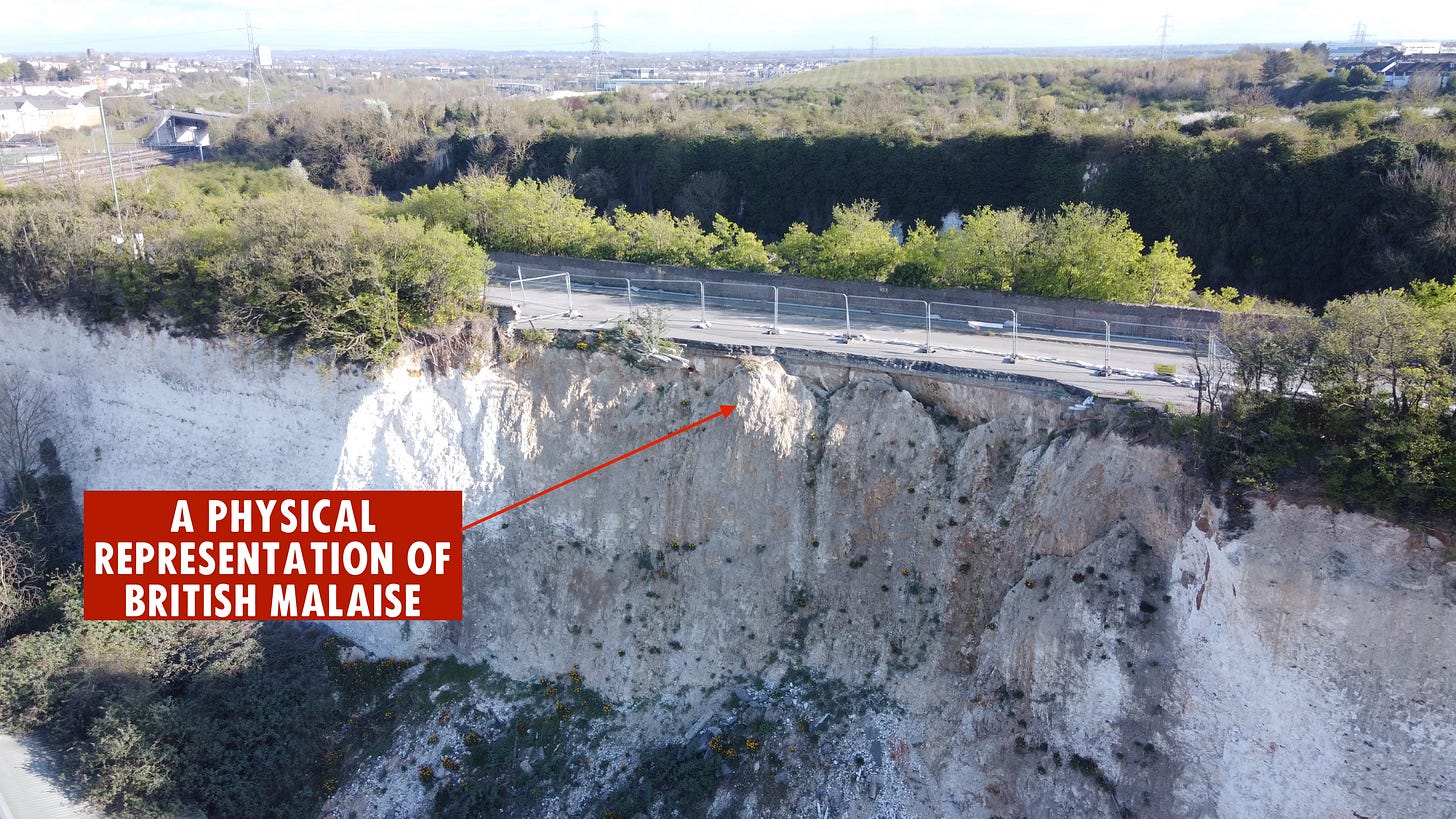

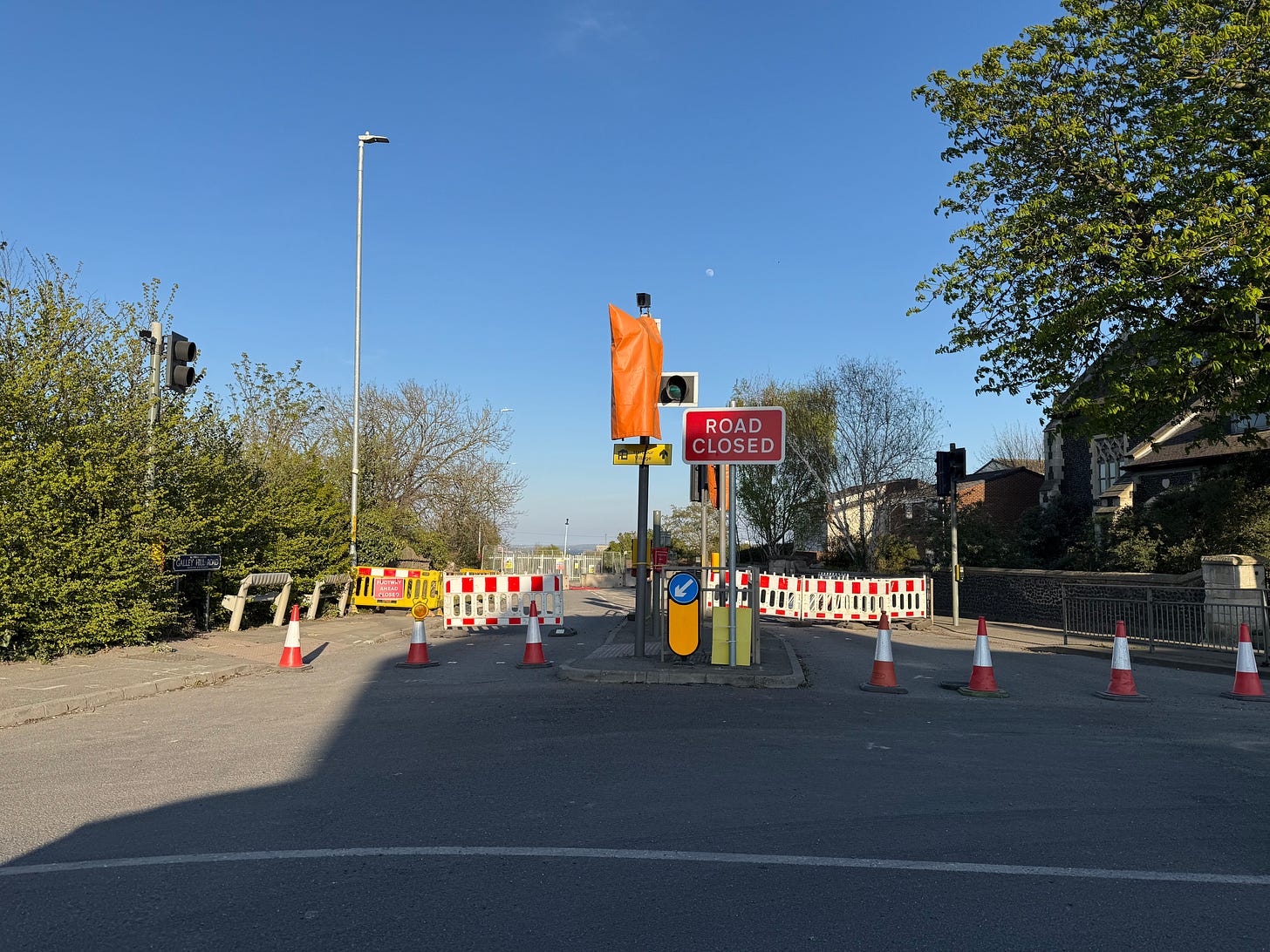
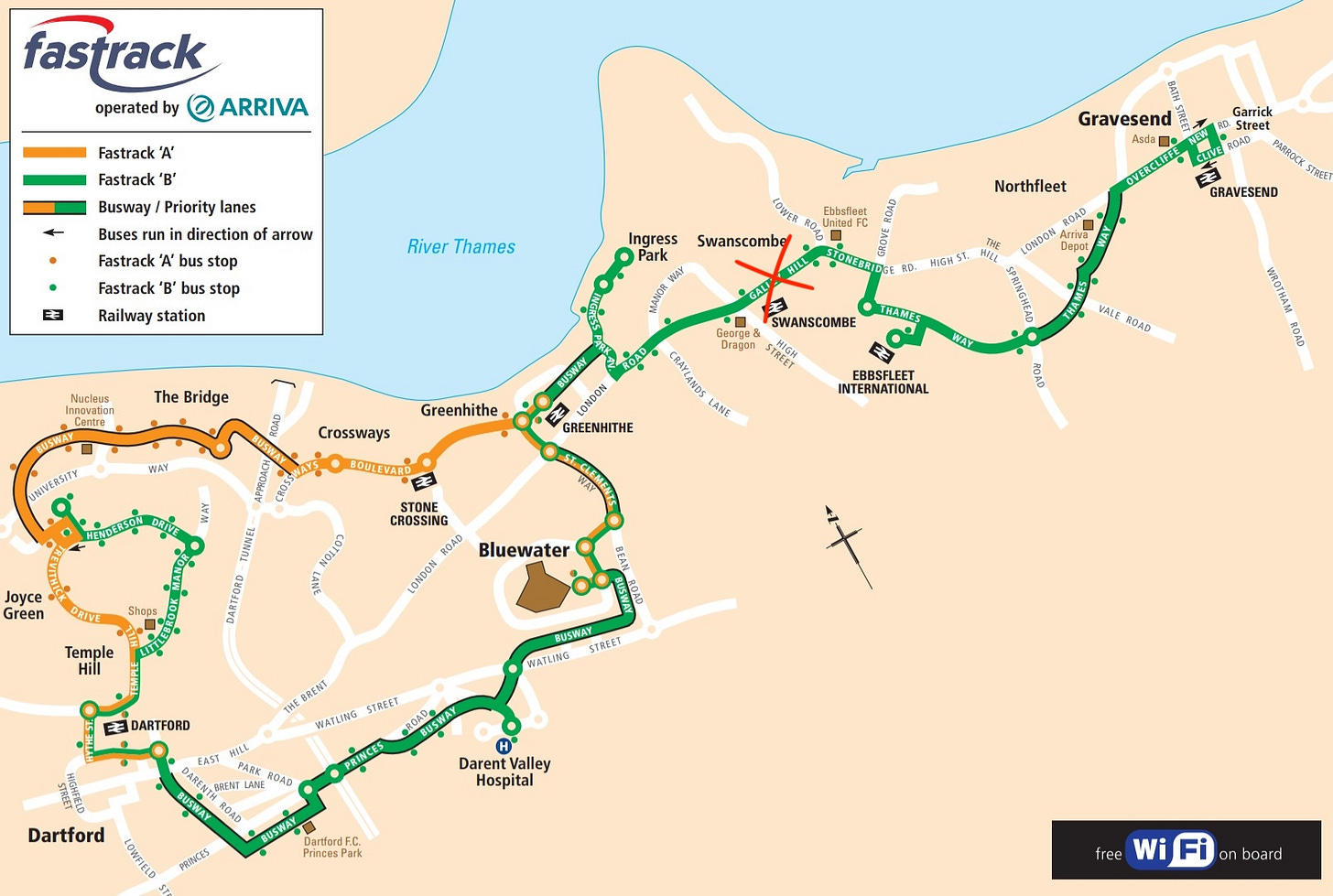
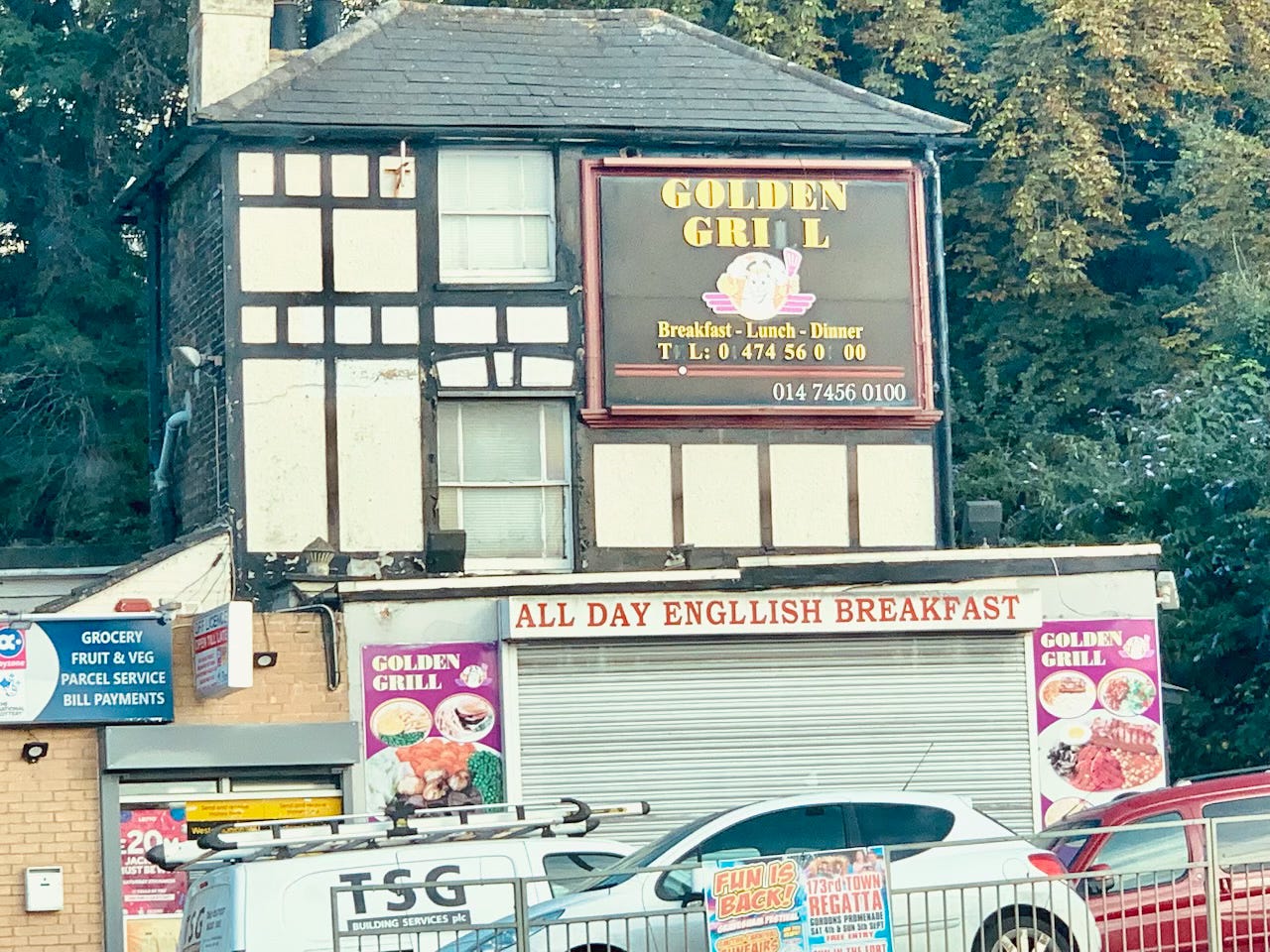

Fascinating story, thanks for sharing. Reading between the lines, as like most things in life, this is pretty much a question of money. And the lack thereof. Local residents are the primary beneficiaries of this road's maintenence, and should pay for it. Why should taxpayers in other regions of the UK pay for something they have a 99.9% likelihood of never using... The problem is that two thirds of an average Local Authority's budget is now spent on adult and children's social care. If local residents would like the road repaired, they should signal their willingness to pay higher local taxes to facilitate this expense by writing to their local politicians - rather than choosing to elect a protest politician who will blame their local woes on channel migrants. A very politically fraught situation, thanks again for sharing.
The longer I spend working in the public sector, the more cynical I get about "partnership working". Sure, for complex delivery you need different partners coming together to sort things out. But very often it's code for wading through an absolutely impenetrable fog of vague accountabilities in order to move half an inch forward. Or even go nowhere.